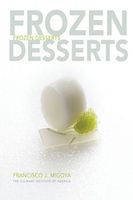Label
All
0
Clear all filters
Method for Frappés: Ices
Appears in
Published 2008
To make an ice, follow the same procedure to make granités up to the freezing and scraping steps.
- Place the main ingredient in a stainless steel bowl. The main ingredient is usually a fruit or vegetable juice, an infused or flavored liquid, or a wine. The infused or flavored liquid can be a dairy product, generally milk (preferably low-fat or fat-free). Even though ices have been classified as non-dairy frozen desserts in this book, they can contain dairy, and they can also have savory applications. However, these two instances are fairly uncommon.
- Make sure that the temperature of the main ingredient is 20°C / 68°F. If not, temper it.
- Add some 65° Brix simple syrup that has a temperature of 20°C / 68°F. In very general terms, a good starting point is 1 part simple syrup to 4 parts of the main ingredient.
- Whisk the mixture thoroughly. Take a reading on the refractometer. It should read 16 to 19° Brix. My personal preference is 17° Brix, which is not too sweet but sweet enough. For savory applications, reduce the Brix to 12 to 15° or less if desired. Always taste to make sure the flavor is to your liking.
- Once the ice mix is made, pour into the desired mold. Don’t forget that an ice should be easy to eat (not awkward or uncomfortable) and small enough to bite into without falling apart or making a mess on the diner’s clothes. Keep this in mind when deciding on a mold. Using a lollipop or Popsicle stick is a good idea if the ice is large enough to be eaten in two or more bites. Otherwise, the diner will be chasing the ice around the plate, and a fork or spoon is not the best utensil for eating a solid piece of ice. You don’t want to force your customers to use a knife to cut through the ice, either. Remember that form always follows function, not the other way around. Also, remember that during freezing, flavors and sugars that are heavier than water will result in an uneven flavor distribution, since they tend to settle at the bottom of the mold. This is yet another reason to keep your ices small, so that they can be eaten whole and the flavors will meld in the mouth.
- Let the ice freeze at –18°C / 0°F until solid. This will only take a fraction of the time in a blast freezer that it takes in a regular freezer.
- Once the ice has solidified, it can be taken out of the mold, but it should be done at the very last minute to prevent freezer burn on your ice. If you do choose to keep all of your ices out of the mold, make sure they are properly covered so that they don’t take on a “freezer taste.” If you are reserving them for longer periods of time (more than 18 hours), make sure that they are kept in the mold in which they are frozen.
- To unmold, place the ice mold into a warm water bath and let sit for a few seconds to ensure that the ice will be released in one piece.
Become a Premium Member to access this page
Unlimited, ad-free access to hundreds of the world’s best cookbooks
Over 160,000 recipes with thousands more added every month
Recommended by leading chefs and food writers
Powerful search filters to match your tastes
Create collections and add reviews or private notes to any recipe
Swipe to browse each cookbook from cover-to-cover
Manage your subscription via the My Membership page
Monthly plan
Annual plan
Part of
Advertisement
Related Recipes
-
-
-
-
Related Reference
-
-
-
-
Advertisement
The licensor does not allow printing of this title



